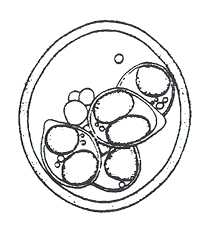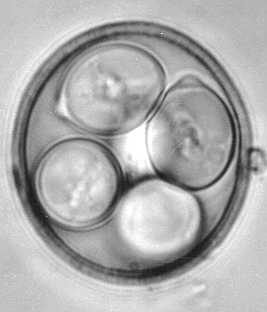Eimeria callospermophili Henry, 1932.
Type host: Spermophilus lateralis (Say,
1823).
Synonyms: Eimeria callispermophili
[lapsus McAllister et
al., 1991]; E. callosphermophili [lapsus]; E.
callospermephili [lapsus]; E. citelli; E.
monacis; E. os; E. perforoides.
Other Names: E. assaensis.
Hosts: Cynomys gunnisoni; C.
leucurus; C. ludovicianus; Marmota baibacina; M. bobak;
M. flaviventris; M. monax; M. sibirica;
Spermophilus armatus; S. beecheyi; S. beldingi;
S. columbianus; S. citellus; S. elegans; S.
erythrogenys; S. franklinii; S. fulvus; S. lateralis;
S. mexicanus; S. relictus; S. richardsonii; S.
spilosoma; S. townsendii; S. tridecemlineatus; S.
undulatus; S.
variegatus.
Type locality: North America, USA, California,
Placer County.
Other localities: Asia: Buriatia; Kazakhstan; North
America: Canada, Alberta; USA,
Colorado, Idaho, Illinois, Iowa, Montana, New York, New Mexico (unpubl. data),
Pennsylvania, Texas, Utah, Wyoming; Central America: Mexico.


Description of oocyst: Oocyst shape: subspheroid;
wall thickness: 1.0-1.5; layers: 1
or 2; outer layer proportion of total thickness: not given; outer layer colour:
yellow; outer layer texture: smooth; inner wall characteristics: smooth; micropyle:
absent; OR: present; OR characteristics: homogenous and clear or granular; OR L x W:
3-5 x 3-5; PG: present; number of PGs: a few; PG shape: not given; PG L x W: not
given; size: 19.2 x 16.0 (16-22 x 16-22); L/W ratio: 1.1 (1.0-1.1). Distinctive
features of oocyst: transparent appearance with large, clear OR; original
description states that the outer wall is slightly rough and one layer thick. In the
original photomicrograph, the wall of the sporulated o÷cyst appears smooth; all
other authors have reported it as smooth. The number of layers has been reported as
1 or 2 by various authors.
Description of sporocysts and sporozoites:
Sporocyst
shape: subspheroid; size: 10.2
x 8.5; SB: present; SB L x W: not given; SB characteristics: pointed; SSB: absent;
PSB: absent; SR: present; SR characteristics: meagre, consisting of a few granules;
SR size: not given; SP: not described. Distinctive features of sporocyst:
none.
Material deposited:: USNPC No. 87249
(phototype).
Remarks: Eimeria callospermophili was
described by Henry (1932) in S. lateralis. In
1931, Crouch & Becker found E. perforoides (described as a new species) and
"E.
monacis" in M. monax. However, their description of E. perforoides
matched Fish's
(1930) description of E. monacis while the form they called E. monacis
matched E.
callospermophili. We consider Crouch & Becker's (1931) E. perforoides to
be E.
monacis and their E. monacis to be E. callospermophili.
Machulsky (1941) identified E. os in M. sibirica, but his
species matches
Crouch & Becker's (1931) E. monacis (= E. callospermophili, see above)
not the
description of E. os.
Svanbaev (1962) reported E. callosphermophili (sic) from Meriones
tamariscinus, but Levine & Ivens (1965) thought Svanbaev saw E.
assaensis. However,
there is no illustration, so E. assaensis is a species inquirenda.
Dorney (1965)
reported E. monacis in M. monax, but the description and
photomicrograph are
indistinguishable from E. callospermophili and do not match the original
description
of E. monacis by Fish (1930). The photomicrograph labelled E. citelli
in Abenov &
Svanbaev (1979) also looks like E. callospermophili.
Fleming et al. (1979) and McQuistion & Wright (1984) reported E.
monacis
from M. monax. They both used Dorney (1965) to aid their identifications, so
what
they all called E. monacis was probably E. callospermophili.
Nukerbaeva & Abenov (1979) described two morphotypes of E.
perforoides (=E.
monacis, see above). The description and photomicrograph of Nukerbaeva &
Abenov's
(1979) round form appear to be of E. callospermophili.
Abenov & Svanbaev (1982) presented a photomicrograph of E. citelli
that
strongly resembles E. callospermophili, while the oocyst in their
photomicrograph of
E. callospermophili is incompletely sporulated.
References: Abenov (1980); Abenov & Svanbaev (1979,
1982); Crouch & Becker (1931);
Dorney (1965); Fish (1930); Fleming et al. (1979); Henry (1932); Hilton & Mahrt
(1971); Levine et al. (1958); Levine & Ivens (1965); McAllister et al. (1991);
McQuistion & Wright (1984); Machulsky (1941, 1949); Nukerbaeva & Abenov
(1979);Seville (1997); Seville et al., (1992); Seville & Stanton (1993b); Shults et
al., (1990); Stanton et al. (1992); Svanbaev (1960, 1962); Thomas & Stanton (1994);
Todd & Hammond (1968a); Torbett et al. (1982); Veluvolu & Levine (1984); Wilber et
al. (1994).



